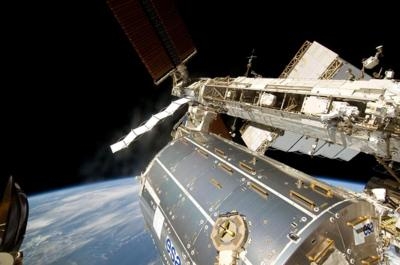Mon, Mar 10, 2014
The Electromagnetic Levitator Will Be Launched To The ISS On ATV-5 To Test Materials Of The Future On The ISS
Airbus Defense and Space, world’s number two in space technologies, has built the Electromagnetic Levitator (EML) facility which was developed under parallel contracts of the European Space Agency ESA and the DLR Space Administration. EML is a containerless processing furnace for materials research in the European Columbus lab, set to uncover a deeper understanding of advanced alloy and semiconductor materials and their molten state properties for the optimization of industrial scale casting as well as for basic research. The EML together with the first batch of samples is part of the cargo complement scheduled to be transported to the International Space Station (ISS) in June by the European resupply spacecraft ATV-5 (Automated Transfer Vehicle).

At least until 2020 the unique test facility will process various metal and semiconductor samples at temperatures of up to 2,000 degrees Celsius in a series of experiments, using the principle of electromagnetic levitation and inductive heating. Several teams of materials scientists and industrial researchers have the objective to acquire high precision data of temperature-dependent thermophysical properties of molten advanced materials, which play a key role in complex casting and solidification processes for these materials when they are used for parts manufacturing on an industrial scale. Performing levitation under microgravity conditions requires only small levitation forces, and deformation of the samples will be avoided which falsifies the measurements based on in-situ optical principles.
It is almost impossible to imagine modern life without products made from high-tech materials. They are used in industrial goods such as jet turbine blades and clean engines for cars. They include supermetals used to make electronic components and high-performance magnets, as well as medical devices such as artificial joints and prosthetics. They are even found in fine metal powders used as catalysts in chemical reactions. Understanding more about materials properties in liquid state for casting models and solidification parameters for these advanced materials is essential both for monitoring the parts’ production process and secure a high quality of the manufactured products.
To this end, a continuous series of experiments are due to be performed by the new EML facility, which will be accommodated in the European Drawer Rack in the Columbus Laboratory on the ISS. Weighing in total approximately 360 kilograms, the EML facility consists of four modules, the most important of which is the Experiment Module (EXM). The samples, which are stored in special containers made from ceramic and rhenium, are fed into the process chamber in a similar arrangement to the magazine of a revolver. This magazine contains 18 spherical metal samples for the experiments, including various aluminium, copper and nickel alloys.
For processing one sample at a time is positioned using electromagnetic levitation and then molten by inductive heating in an electromagnetic field generated by a coil system. Numerous parameters can then be measured simultaneously on the levitated metal droplet. Containerless non-contact methods will be used for all the experiments in order to avoid any interference on the measurements compared to the necessary use of a crucible on ground.
Operation of the Electromagnetic Levitator will be controlled and monitored by the German Aerospace Center’s User Control Center (MUSC) in Cologne. The scientists in charge of the experiments can carry out real-time, direct tracking of each and every detail of the melt cycles from this control center thanks to a digital video observation camera, a high-speed data camera capable of capturing up to 30,000 images per second, and a pyrometer. Before flight the individual sample materials have been thoroughly characterized before on parabolic flights with the Tempus facility provided by DLR. The ISS samples can even be returned to Earth at a later point in time to enable the researchers to perform further testing.
The Electromagnetic Levitator facility was developed and built by teams of Airbus Defense and Space Systems as industrial prime contractor. With over 25 years of experience in this field, Friedrichshafen experts built a number of flight units as part of the Tempus project, for parabolic flights (20 second experiment duration), sounding rockets (6 minutes) and for three Spacelab missions on board the U.S. Space Shuttle (1–2 weeks’ mission duration) in the 1990s. Nowadays the ISS laboratories provide continuous access to microgravity conditions.
(Image provided by Airbus Defense and Space)
More News
Also: Vertical Flight Society, NBAA Maintenance Conference, GA Honored, AMT Scholarship For the first time, students from Embry-Riddle’s Daytona Beach, Florida, campus took t>[...]
Hazardous Weather Information Summary of significant meteorological information (SIGMET/WS), convective significant meteorological information (convective SIGMET/WST), urgent pilot>[...]
"The need for innovation at speed and scale is greater than ever. The X-62A VISTA is a crucial platform in our efforts to develop, test and integrate AI, as well as to establish AI>[...]
(FAA) Inspector Observed That Both Fuel Tanks Were Intact And That Only A Minimal Amount Of Fuel Remained In Each Analysis: According to the pilot, approximately 8 miles from the d>[...]
“Pyka’s Pelican Cargo is unlike any other UAS solution on the market for contested logistics. We assessed a number of leading capabilities and concluded that the Pelica>[...]
 Airborne-Flight Training 05.09.24: ERAU at AIAA, LIFT Diamond Buy, Epic A&P
Airborne-Flight Training 05.09.24: ERAU at AIAA, LIFT Diamond Buy, Epic A&P ANN's Daily Aero-Term (05.07.24): Hazardous Weather Information
ANN's Daily Aero-Term (05.07.24): Hazardous Weather Information Aero-News: Quote of the Day (05.07.24)
Aero-News: Quote of the Day (05.07.24) NTSB Final Report: Cessna 150
NTSB Final Report: Cessna 150 Aero-News: Quote of the Day (05.08.24)
Aero-News: Quote of the Day (05.08.24)



